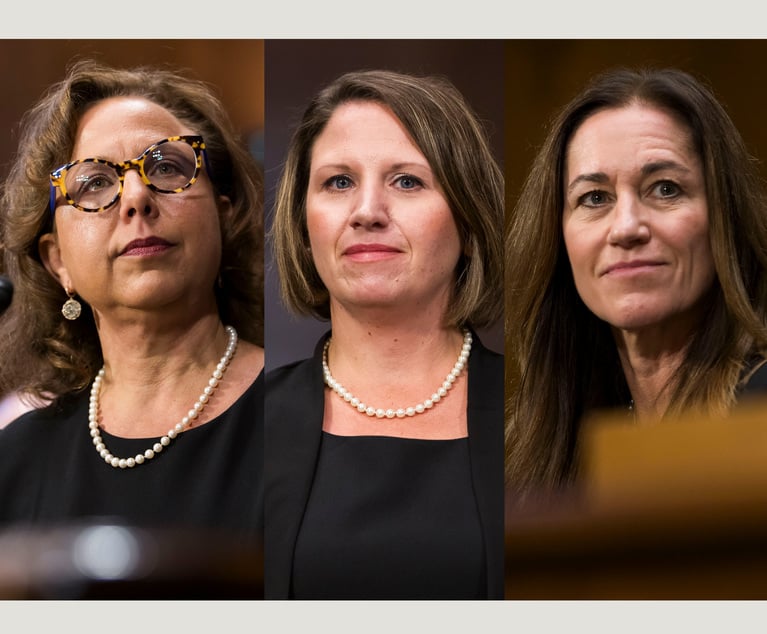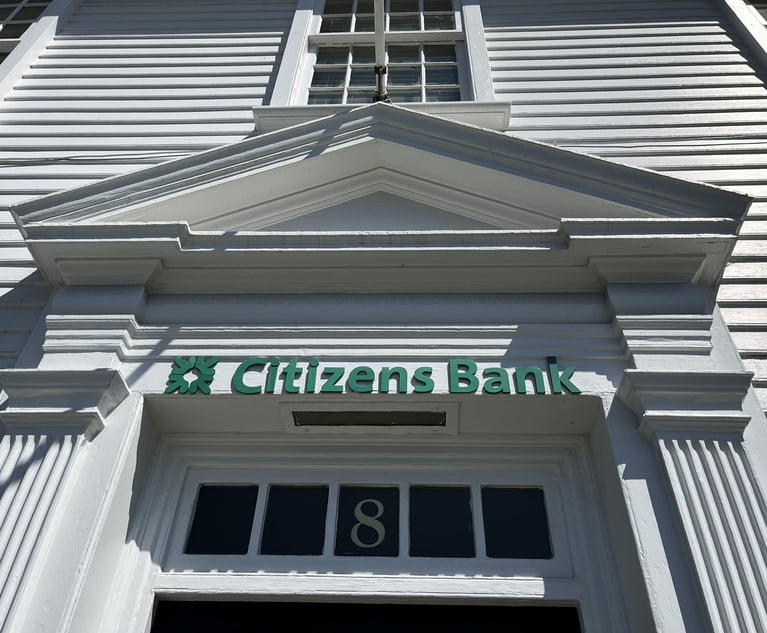Why Cashing In on #Trending Trademarks Always Ends in Failure
In the heyday of the video-sharing service Vine, Kayla Newman, a Chicago-area teen, birthed a new catchphrase for the millennial generation with two words—“on fleek.”
March 30, 2018 at 04:21 PM
8 minute read

In the heyday of the video-sharing service Vine, Kayla Newman, a Chicago-area teen, birthed a new catchphrase for the millennial generation with two words—“on fleek.” Her original video had 20 million views on Vine, and on Instagram the hashtag “#onfleek” was mentioned over 200,000 times. Shortly thereafter five different third parties, including the teen, applied to register the phrase “on fleek” at the U.S. Patent & Trademark Office (USPTO). Only one entity was able to successfully register the mark for cosmetics and makeup. And the successful registrant was not Newman, whose application is currently suspended. In interviews, Newman expressed frustration with not being able to monetize her contribution to the cultural milieu. As Newman put it, she “gave the world a word” and never saw a dime.
Social media and the connections it creates has led to the “viralization” of culture, as evidenced by the speed with which hashtags like #MeToo and #BlackGirlMagic or social movements like Time's Up enter the collective consciousness and become household words. And as soon as they do, individuals and businesses seek to capitalize on the movements, memes and catchphrases that generate the most views. For many, trademark registration is seen as the way to cash in by obtaining exclusive rights to something everyone else wants to use or say. This instinct is understandable but misguided. In reality, the widespread use of any expression dooms its ability to function as a trademark because it will never have meaning to consumers apart from the cultural significance the phrase has attained. These “social trademarks” are therefore not trademarks at all.
What Is a Trademark?
To understand why widespread catchphrases cannot function as trademarks, it is important to first understand what a trademark is and what purpose it serves. At its most basic, a trademark is a word or symbol (or, more rarely, a sound or smell) that distinguishes the goods or services of one business from those of another. The ability of a trademark to allow consumers to tell one business' product from another is the trademark's “source-identifying” function.
A mark must be able to function as a source-identifier, and it must also be “distinctive,” meaning that the mark is capable of distinguishing one party's goods from another's. Words that simply describe features of the goods—“soft and silky” used on bed sheets for example—are not distinctive because consumers perceive them as providing information about the goods, not as indicating that they come from a particular manufacturer. Thus, the strongest and most distinctive trademarks are those that bear no relation to the goods or services they are used on, such as Amazon for an online retailer. Because no other online retailer needs to use the word Amazon to describe its own services, Amazon is a distinctive mark and consumers who encounter Amazon in the online retail world can be confident they are receiving services from Amazon and not a competitor.
Trademark law acts as a consumer protection regime as much as an intellectual property one. Patents and copyrights protect inventors and authors, respectively, without regard to how consumers perceive the invention or copyrightable work at issue. Trademarks, on the other hand, are only protectable to the extent necessary to protect consumers from being confused about the source of goods or services. The rights that trademark law provides brand owners are not an end in themselves; rather, by ensuring consumers can identify and distinguish between brands, the system creates marketplace efficiencies to allow people to make informed decisions about the products or services they purchase. Marks that cannot serve this purpose (i.e., identify the source of goods or services, and distinguish them from the products or services of another), are not trademarks at all and therefore cannot be registered as such. After all, “the Trademark Act is not an act to register words but to register trademarks,” as in In re The Standard Oil, 125 USPQ 227, 229 (C.C.P.A. 1960) (emphasis added).
Why Social Trademarks Are #DOA
As we use the term, a “social trademark” is a word, phrase, or symbol that, by virtue of “going viral” or otherwise, has attained widespread use and cultural significance. Catchphrases like “on fleek,” memes like “pizza rat,” and social movements like “Occupy Wall Street” all fall into this category. Attempts to register or prevent others from using such “social trademarks” are antithetical to the trademark system. That is because a word, phrase, or symbol that has been used so broadly and frequently as to have embedded itself in our collective culture simply cannot function as a source-identifier. Consumers who come across the term are likely to understand it to refer to the social movements or memes or viral videos that spawned it, rather than as a trademark designating the goods from a particular source.
These basic principles go to the heart of what a trademark is and is not, and they are embedded in the USPTO's practices for examining trademarks. The USPTO examines trademark applications to evaluate whether marks are entitled to registration, either on the Principal Trademark Register (for inherently distinctive marks) or the Supplemental Register (for descriptive marks capable of acquiring distinctiveness). Section 1202.04(b) of the Trademark Manual of Examining Procedure (TMEP), which trademark examining attorneys use as a guide to determine whether a mark can register, requires the examiner to reject an application that seeks to register a “widely used message.” The rationale for the rejection falls squarely in line with the basic functions of trademarks: “Messages that are used by a variety of sources to convey social, political, religious or similar sentiments or ideas are likely to be perceived as an expression of support for, or affiliation or affinity with, the ideas embodied in the message rather than as a mark that indicates a single source of the goods or services.” Consistent with this rationale, a trademark applicant cannot overcome this rejection by claiming that the applied-for mark has acquired distinctiveness, and cannot seek to register the mark on the Supplemental Register (where descriptive marks can generally be registered until they have acquired distinctiveness). Social trademarks are not capable of acquiring distinctiveness because their widespread use makes it impossible for them to serve the core purpose of trademarks: designating a single source for goods or services.
In this regard, social trademarks are analytically analogous to generic marks. A generic term is the common descriptive name of a class of goods or services. Generic marks—like social trademarks—can never function as marks because consumers understand them to refer to the class of goods, rather than a particular source, like “coffee shop” as a name for a store that sells coffee. Generic marks, therefore, are unprotectable because they will always designate the product, and not the producer. Likewise, social trademarks are unprotectable because they will always designate a social movement, widely used catchphrase, or commonly understood symbol, rather than a producer of goods or services. Thus, the rationale for refusing to protect social trademarks is similar to the rationale for refusing to protect generic ones: both fail in the most basic function of a trademark.
What Does This Mean for Budding Entrepreneurs?
The desire to capitalize on popular social movements is understandable—but those who think the key to commercial success is to attempt to “lock up” popular words by trying to register them will ultimately be disappointed. Trademark law does not allow individuals or businesses to “own” particular words; it only allows them to claim a right to exclusively use a trademark to the extent necessary to prevent consumer confusion. When, as with social trademarks, consumers do not perceive a word as an indication of a product's source, there is no trademark at all, and therefore nothing to protect. But that has not stopped would-be entrepreneurs (and even established market participants) from trying. For example, in the wake of the Boston Marathon bombing, nine applications were filed by nine different applicants for the mark “Boston Strong” for products ranging from apparel to beer. Eight of the nine applications were refused registration on the grounds that the mark Boston Strong does not function as a trademark. (The application that did not receive a “failure to function” refusal was expressly abandoned by the applicant prior to examination). In each instance, trademark examining attorneys took the position that the use of Boston Strong in connection with the marathon bombing was so ubiquitous that it could do no more than convey an informational message and thus would not be perceived by consumers as a mark, but rather, a motto or slogan that defined the culture of Boston at that time.
With the next viral meme, hashtag, movement, or tragedy will come a flood of trademark applications. Do not be among the inevitable, and doomed, that will spend money on filing fees only to be refused trademark registration.
Jenna Loadman, an associate at Ballard Spahr, concentrates her practice on trademark and copyright matters, including counseling, prosecution, enforcement, and portfolio management. She assists in the management of worldwide trademark portfolios, which includes counseling businesses of all sizes with respect to the clearance, selection, use, registration, and enforcement of trademarks.
Tyler Marandola is an associate in the firm's intellectual property litigation group. He prosecutes and defends cases involving patents, copyrights, trademarks, licensing, unfair competition, and other commercial disputes.
This content has been archived. It is available through our partners, LexisNexis® and Bloomberg Law.
To view this content, please continue to their sites.
Not a Lexis Subscriber?
Subscribe Now
Not a Bloomberg Law Subscriber?
Subscribe Now
NOT FOR REPRINT
© 2025 ALM Global, LLC, All Rights Reserved. Request academic re-use from www.copyright.com. All other uses, submit a request to [email protected]. For more information visit Asset & Logo Licensing.
You Might Like
View All
Pa. Federal District Courts Reach Full Complement Following Latest Confirmation

The Defense Bar Is Feeling the Strain: Busy Med Mal Trial Schedules Might Be Phila.'s 'New Normal'
7 minute read
Federal Judge Allows Elderly Woman's Consumer Protection Suit to Proceed Against Citizens Bank
5 minute read
Judge Leaves Statute of Limitations Question in Injury Crash Suit for a Jury
4 minute readTrending Stories
Who Got The Work
J. Brugh Lower of Gibbons has entered an appearance for industrial equipment supplier Devco Corporation in a pending trademark infringement lawsuit. The suit, accusing the defendant of selling knock-off Graco products, was filed Dec. 18 in New Jersey District Court by Rivkin Radler on behalf of Graco Inc. and Graco Minnesota. The case, assigned to U.S. District Judge Zahid N. Quraishi, is 3:24-cv-11294, Graco Inc. et al v. Devco Corporation.
Who Got The Work
Rebecca Maller-Stein and Kent A. Yalowitz of Arnold & Porter Kaye Scholer have entered their appearances for Hanaco Venture Capital and its executives, Lior Prosor and David Frankel, in a pending securities lawsuit. The action, filed on Dec. 24 in New York Southern District Court by Zell, Aron & Co. on behalf of Goldeneye Advisors, accuses the defendants of negligently and fraudulently managing the plaintiff's $1 million investment. The case, assigned to U.S. District Judge Vernon S. Broderick, is 1:24-cv-09918, Goldeneye Advisors, LLC v. Hanaco Venture Capital, Ltd. et al.
Who Got The Work
Attorneys from A&O Shearman has stepped in as defense counsel for Toronto-Dominion Bank and other defendants in a pending securities class action. The suit, filed Dec. 11 in New York Southern District Court by Bleichmar Fonti & Auld, accuses the defendants of concealing the bank's 'pervasive' deficiencies in regards to its compliance with the Bank Secrecy Act and the quality of its anti-money laundering controls. The case, assigned to U.S. District Judge Arun Subramanian, is 1:24-cv-09445, Gonzalez v. The Toronto-Dominion Bank et al.
Who Got The Work
Crown Castle International, a Pennsylvania company providing shared communications infrastructure, has turned to Luke D. Wolf of Gordon Rees Scully Mansukhani to fend off a pending breach-of-contract lawsuit. The court action, filed Nov. 25 in Michigan Eastern District Court by Hooper Hathaway PC on behalf of The Town Residences LLC, accuses Crown Castle of failing to transfer approximately $30,000 in utility payments from T-Mobile in breach of a roof-top lease and assignment agreement. The case, assigned to U.S. District Judge Susan K. Declercq, is 2:24-cv-13131, The Town Residences LLC v. T-Mobile US, Inc. et al.
Who Got The Work
Wilfred P. Coronato and Daniel M. Schwartz of McCarter & English have stepped in as defense counsel to Electrolux Home Products Inc. in a pending product liability lawsuit. The court action, filed Nov. 26 in New York Eastern District Court by Poulos Lopiccolo PC and Nagel Rice LLP on behalf of David Stern, alleges that the defendant's refrigerators’ drawers and shelving repeatedly break and fall apart within months after purchase. The case, assigned to U.S. District Judge Joan M. Azrack, is 2:24-cv-08204, Stern v. Electrolux Home Products, Inc.
Featured Firms
Law Offices of Gary Martin Hays & Associates, P.C.
(470) 294-1674
Law Offices of Mark E. Salomone
(857) 444-6468
Smith & Hassler
(713) 739-1250





